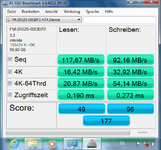Link Power Management with Intel® Rapid Storage Technology
Intel® Rapid Storage Technology implements the Link power management (LPM) feature described by the Serial ATA specification to overcome the power demand of a high-speed serial interface, SATA and providing the capability of SATA at the minimum power cost. LPM, when used in conjunction with a SATA hard drive that supports this feature, enables lower power consumption. LPM was initially enabled by default on mobile platforms starting with ICH6M with Intel® Matrix Storage Manager. Starting with ICH9R this feature has also been supported on desktop platforms with Intel® Matrix Storage Manager 7.5 release but not enabled by default. Beginning with the Intel® Rapid Storage Technology 10.0 release, LPM support is enabled by default on both mobile and desktop platforms. OEM’s who wish to modify the default settings for LPM on their platforms can follow the instructions in the following section(s).
Instructions to disable/enable LPM
After system is setup with OS and Intel® Rapid Storage Technology installed, follow the below instructions to modify the default LPM support.
NOTE: Beginning with the Intel® Rapid Storage Technology 10.0 release, the registry keys are no longer populated in the Windows registry by default. The RST driver does not require the registry keys to be present to support the default settings.
1. Go to Start->Run
2. Type in RegEdit and hit the Enter Key.
3. Go to the below mentioned location to insert or configure the registry keys for LPM
NOTE: OEM’s need to configure the LPM settings by port. Ports are numbered starting with zero (please refer the desired platform EDS for the number of ports supported on that platform)
HKEY_LOCAL_MACHINE\System\CurrentControlSet\Servic es\iaStor\Parameters\Port0\
HKEY_LOCAL_MACHINE\System\CurrentControlSet\Servic es\iaStor\Parameters\Port1\
…
HKEY_LOCAL_MACHINE\System\CurrentControlSet\Servic es\iaStor\Parameters\Port5\
4. Now add the following registry keys under the registry location mentioned in step3, if they are not available (These registry keys are not available by default, they can be added by using utomated scripts, .reg files, executable utilities, etc). If you find the below registry keys already available, you can modify the values for desired support. Values are modified on a port by port basis so modify all ports that you wish the changes to be supported on. **
“LPM”=dword: 00000001 {dword: 00000000->Disable; dword: 00000001->Enable} [default = Enabled]
“LPMSTATE”=dword: 00000000 {dword: 00000000->Partial; dword: 00000001->Slumber} [default = Disabled] (Note: the driver ignores this key when the LPM key’svalue is not set to 1. So when LPM value is 0, this value is N/A.)
“LPMDSTATE”=dword: 00000001 {dword: 00000000->Partial; dword: 00000001->Slumber} [default = Enabled]
“DIPM”=dword: 00000001 {dword: 00000000->Disable; dword: 00000001->Enable} [default = Enabled]
**Warning: If you edit the registry incorrectly, you can cause serious problems that may require you to reinstall your operating system. Intel does not guarantee that problems that are caused by editing the Registry incorrectly can be resolved.







